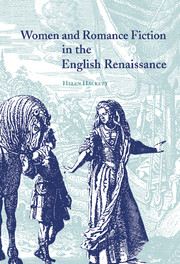Book contents
- Frontmatter
- Contents
- Acknowledgements
- List of abbreviations and a note on the text
- Introduction
- 1 The readership of Renaissance romance
- 2 Renaissance romance and modern romance
- 3 Novellas of the 1560s and 1570s
- 4 Spanish and Portuguese romances
- 5 Fictions addressed to women by Lyly, Rich and Greene
- 6 The ‘Arcadia’: readership and authorship
- 7 The ‘Arcadia’: heroines
- 8 ‘The Faerie Queene’
- 9 Shakespeare's romance sources
- 10 Lady Mary Wroth's ‘Urania’
- Epilogue: The later seventeenth century
- Notes
- Bibliography
- Index
1 - The readership of Renaissance romance
Published online by Cambridge University Press: 01 September 2009
- Frontmatter
- Contents
- Acknowledgements
- List of abbreviations and a note on the text
- Introduction
- 1 The readership of Renaissance romance
- 2 Renaissance romance and modern romance
- 3 Novellas of the 1560s and 1570s
- 4 Spanish and Portuguese romances
- 5 Fictions addressed to women by Lyly, Rich and Greene
- 6 The ‘Arcadia’: readership and authorship
- 7 The ‘Arcadia’: heroines
- 8 ‘The Faerie Queene’
- 9 Shakespeare's romance sources
- 10 Lady Mary Wroth's ‘Urania’
- Epilogue: The later seventeenth century
- Notes
- Bibliography
- Index
Summary
RENAISSANCE ROMANCE AS WOMEN'S READING
Various kinds of evidence support the view of Louis Wright and others that the commercial success of Renaissance romances was attributable to a new female readership. Many Elizabethan and Jacobean romance authors included in their works dedicatory prefaces and incidental narrative asides which specifically addressed ‘gentlewomen’ readers, that is, women of middle rank. John Lyly began Euphues and his England (1580), the sequel to Euphues: the Anatomy of Wit, with an epistle ‘To the Ladies and Gentlewomen of England’, beseeching them to ‘take the pains to read it, but at such times as you spend in playing with your little dogs’, and to have ‘Euphues … as often in your hands, being but a toy, as lawn on your heads, being but trash’. Barnaby Rich included a similar dedication ‘To the right courteous gentlewomen’ in Rich's Farewell to Military Profession (1581), a collection of romance-type stories, explaining that he had turned away from military pursuits in favour of the more fashionable entertainment of ladies. His title page declared his tales to have been ‘Gathered together for the onely delight of the courteous Gentlewomen … for whose onely pleasure thei were collected together’. Robert Greene informed ‘Gentlewomen’ readers of Penelope's Web (1587), another collection of romance tales, that it was aimed at ‘discovering [i.e. revealing, publicising] the vertues of your sex’.
By the early seventeenth century, foolish female readers of romance had become favourite subjects for satirists and moralists.
- Type
- Chapter
- Information
- Women and Romance Fiction in the English Renaissance , pp. 4 - 19Publisher: Cambridge University PressPrint publication year: 2000



